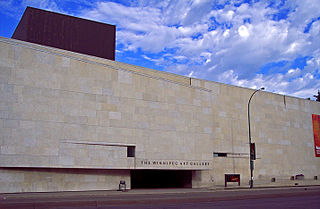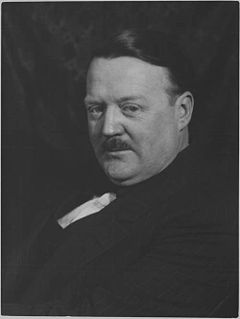Related Research Articles

The Winnipeg Art Gallery (WAG) is an art museum in Winnipeg, Manitoba, Canada. Its permanent collection includes over 24,000 works from Canadian, and indigenous Canadians, and international artists. The museum also holds the world's largest collection of Inuit art. In addition to exhibits for its collection, the museum has organized and hosted a number of travelling arts exhibitions. Its building complex consists of a main building that includes 11,000 square metres (120,000 sq ft) of indoor space and the adjacent 3,700-square-metre (40,000 sq ft) Inuit Art Centre.

Francis Hans Johnston, also known as Frank H. Johnston and as Franz Johnston, was a member of the Group of Seven.

Jessie Oonark, was a prolific and influential Canadian Inuit artist of the Utkuhihalingmiut Utkuhiksalingmiut whose wall hangings, prints and drawings are in major collections including the National Gallery of Canada. She was born in 1906 in the Chantrey Inlet (Tariunnuaq) area, near the estuary of the Back River in the Keewatin District of the Northwest Territories —the traditional lands of the Utkukhalingmiut Utkukhalingmiut, Utkukhalingmiut. Her artwork portrays aspects of the traditional hunter-nomadic life that she lived for over five decades, moving from fishing the camp near the mouth of Back River on Chantrey Inlet in the Honoraru area to their caribou hunting camp in the Garry Lake area, living in winter snow houses (igloos) and caribou skin tents in the summer. Oonark learned early how to prepare skins and sew caribou skin clothing. They subsisted mainly on trout, whitefish, and barren-ground caribou. The knife used by women, the ulu, their clothing, the kamik, the amauti were recurring themes in her work. Oonark has had a major museum retrospective with accompanying scholarly monograph. Despite a late start – she was 54 years old when her work was first published – she was a very active and prolific artist over the next 19 years, creating a body of work that won considerable critical acclaim and made her one of Canada's best known Inuit artists.

The Manitoba Museum, previously the Manitoba Museum of Man and Nature, is a historical museum in Winnipeg, Manitoba, as well as the province’s largest, not-for-profit centre for heritage and science education.

Leonid Molodozhanyn, known as Leo Mol, was a Ukrainian Canadian stained glass artist, painter and sculptor.

Wanda Koop is an internationally acclaimed Canadian interdisciplinary artist who lives and works in Winnipeg, Manitoba. She is widely regarded as one of Canada’s most distinguished and inventive painters.
Gerald Ferguson was a conceptual artist and painter who lived and taught in Halifax, Nova Scotia. Born in Cincinnati he was both a Canadian and US citizen.

The Mendel Art Gallery was a major creative cultural centre in City Park, Saskatoon, Saskatchewan. Operating from 1964 to 2015, it housed a permanent collection of more than 7,500 works of art. The gallery was managed by the city-owned Saskatoon Gallery and Conservatory Corporation, which also managed the Mendel's sister institution, the Saskatoon Civic Conservatory. In 1999, it was the 16th largest public art gallery in Canada by budget size and had the sixth highest overall attendance in the country. By 2010, it had more than 180,000 visitors.

Robert Houle is a Saulteaux First Nations Canadian artist, curator, critic, and educator. Houle has had an active curatorial and artistic practice since the mid-1970s. He played an important role in bridging the gap between contemporary First Nations artists and the broader Canadian art scene through his writing and involvement in early important high-profile exhibitions such as Land, Spirit, Power: First Nations at the National Gallery of Canada. As an artist, Houle has shown both nationally and internationally. He is predominantly a painter working in the tradition of Abstraction, yet he has also embraced a pop sensibility by incorporating everyday images and text into his works. His work addresses lingering aspects of colonialism and their effects on First Nation peoples. Houle often appropriates historical photographs and texts, repurposing and combining them with Anishnaabe language and traditionally used materials such as porcupine quills within his works.
KC Adams is a Cree, Ojibway, and British artist and educator based in Winnipeg, Manitoba.
Jane Ash Poitras is a Cree painter and printmaker from Canada. Her work uses the idioms of mainstream art to express the experience of Aboriginal people in Canada.

Janet Kigusiuq was an Inuit artist. Kigusiuq came from a large family of artists: she was the eldest daughter of Jessie Oonark, her siblings included artists Victoria Mamnguqsualuk, Nancy Pukingrnak, Peggy Qablunaaq Aittauq, Mary Yuusipik Singaqti, Josiah Nuilaalik, Miriam Marealik Qiyuk, and William Noah, and she was married to Mark Uqayuittuq, son of Luke Anguhadluq, themselves both artists.
Aganetha Dyck is a Canadian sculpture artist residing in Winnipeg, Manitoba. Dyck is best known for her work with live honeybees, that build honeycomb on objects that she introduces to honeybee hives. In 2007 Dyck was awarded both Manitoba's Arts Award of Distinction and Canada's Governor General's Award in Visual and Media Arts.
Sheila Butler is an American-Canadian visual artist and retired professor. Her collections are featured at the National Gallery of Canada, the Art Gallery of Hamilton, the University of Toronto, the Winnipeg Art Gallery and University of Manitoba in Winnipeg. She is a founding member of Mentoring Artists for Women's Art in Winnipeg, Manitoba and the Sanavik Inuit Cooperative in Baker Lake, Nunavut. She is a fellow of the Royal Canadian Academy of Arts.
Diana Thorneycroft is a Canadian artist based in Winnipeg, Manitoba, whose work has exhibited nationally and internationally. Thorneycroft works primarily in photography, drawing, and sculpture/installation. Her work blurs the lines between gendered bodies by employing phalluses.
Eleeshushe Parr was an Inuk graphic artist and sculptor, from the Kingnait area, who produced over 1,160 drawings. Her work has been exhibited in Canada, the United States, and Sweden.
Hannah Kigusiuq (1931-1995) was an Inuk artist. Kigusiuq was born at Hanningajuq, Northwest Territories. She is known for her drawings and prints.
Lissie Saggiak, also known as Lizzie Saggiak, (1924-1989) was an Inuit artist. Saggiak was born in Salluit, Quebec. She is known for her drawings and sculptures.
Lucy Meeko (1929-2004) was an Inuit artist known for her multidisciplinary work in sculpture, printmaking, basketry and sewing. Meeko was born in Kuujjuaraapik, Quebec. Her career as a sculptor began in the 1950s; in the 1970s, together with her husband Noah, she created engravings for the Kuujjuarapic Cooperative.
Elizabeth Nutaraluk Aulatjut was an Inuit sculptor.
References
- ↑ "Elizabeth Kugmucheak Alooq – People – McMichael Canadian Art Collection". collections.mcmichael.com. Archived from the original on 2019-11-01. Retrieved 2019-11-01.
- ↑ "Art Search | Winnipeg Art Gallery". www.wag.ca. Archived from the original on 2019-11-01. Retrieved 2019-11-01.
| | This article about a Canadian artist is a stub. You can help Wikipedia by expanding it. |